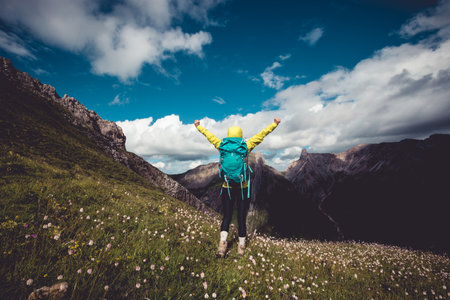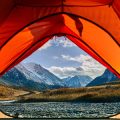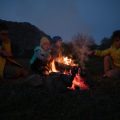1. Choosing the Wrong Campsite
One of the most common mistakes beginner campers make is picking the wrong campsite. It might seem like any open space in nature will do, but there are several key factors to consider that can make or break your camping experience.
Location Matters
Not all campgrounds are created equal. Some are remote and peaceful, while others are close to highways or noisy areas. Think about how far youre willing to drive, whether you want solitude or social interaction, and how close you need to be to facilities like bathrooms or water sources.
Terrain and Ground Conditions
The ground where you pitch your tent plays a huge role in your comfort and safety. Avoid sloped areas where youll slide during the night, and steer clear of rocky or root-covered ground that can make sleeping uncomfortable. Also, avoid low-lying spots that could collect water if it rains.
Check the Weather Forecast
Always research weather conditions before choosing your site. Some locations are prone to strong winds, heavy rain, or sudden temperature drops. If youre not experienced with extreme weather camping, opt for a more sheltered spot with mild conditions.
Amenities and Accessibility
Beginner campers often overlook what amenities are available at a site. Do you need running water? Flush toilets? A fire ring? Cell service? Make sure the site matches your comfort level and needs. Heres a quick comparison table:
| Amenity | What to Look For | Why It Matters |
|---|---|---|
| Water Access | Nearby spigot or stream (if treated) | Essential for drinking, cooking, and cleaning |
| Restrooms | Flush toilets or clean vault toilets | Makes the trip more comfortable, especially for families |
| Fire Ring/Grill | Designated area for fires/cooking | Keeps fire safe and controlled; easier meal prep |
| Parking Access | Close proximity to campsite | Saves time and energy hauling gear |
Know Your Skill Level
If youre new to camping, dont challenge yourself with a backcountry site miles from help. Start at established campgrounds with clear signage and accessible paths. As your confidence grows, you can try more adventurous spots.
Quick Tips for Choosing the Right Campsite:
- Read online reviews on apps like The Dyrt or Campendium.
- Look at photos and maps before booking.
- Call ahead to ask about current conditions.
- Double-check rules about pets, fires, and reservations.
Picking the right campsite sets the tone for your entire trip. Take the time to research ahead so you don’t end up stuck in a muddy pit next to a noisy generator.
2. Packing Improperly or Forgetting Essentials
Packing can make or break your camping experience—especially if youre new to the outdoors. One of the most common beginner mistakes is either bringing way too much stuff or forgetting key items that you absolutely need.
Common Packing Mistakes
Here are some of the most frequent packing errors beginners make:
- Overpacking: Bringing too many clothes, kitchen gadgets, or unnecessary gear that clutters your space and adds weight.
- Underpacking: Forgetting essentials like a first aid kit, flashlight/headlamp, or weather-appropriate clothing.
- No Organization: Tossing everything into one bag without order makes it hard to find things quickly when you need them.
Must-Have Camping Essentials
Before heading out, double-check that you’ve packed all the basics. Heres a simple checklist to help you cover the essentials:
| Category | Essential Items |
|---|---|
| Shelter & Sleep | Tent, ground tarp, sleeping bag, sleeping pad, pillow |
| Clothing | Weather-appropriate layers, extra socks, rain jacket, hat |
| Cooking Gear | Portable stove, fuel, cookware, utensils, lighter/matches |
| Food & Water | Prepped meals/snacks, water bottles or hydration system, water filter or purification tablets |
| Safety & Navigation | First aid kit, headlamp/flashlight with extra batteries, map/compass or GPS device |
| Personal Items | Sunscreen, bug spray, toiletries, hand sanitizer, toilet paper |
Packing Tips for Beginners
Create a Checklist Ahead of Time
A few days before your trip, start building a checklist based on your destination’s weather and planned activities. This helps avoid last-minute scrambling and forgotten items.
Pack in Categories
Use separate bags or containers for different categories (e.g., cooking gear in one bin, clothes in another). It keeps your camp organized and makes set-up easier.
Test Your Gear at Home
If it’s your first time using a tent or stove, practice setting it up at home so you’re not struggling with instructions at the campsite in the dark.
Quick Pro Tip:
Always pack a small “essentials bag” with your flashlight, phone charger/power bank, multi-tool, and first aid kit—this should be easy to grab anytime.
Packing smart doesn’t just save time—it can also keep you safe and stress-free during your adventure. Stay organized and prep ahead for a smooth start to any camping trip!
![]()
3. Neglecting Weather Preparation
One of the biggest mistakes beginner campers make is not preparing for unpredictable weather. Even if the forecast looks clear, weather can change quickly—especially in mountainous or forested areas. Failing to plan for rain, cold nights, or sudden temperature drops can lead to serious discomfort or even danger.
Why It Matters
Being caught off guard by bad weather can ruin your trip. Wet clothes, freezing temperatures at night, or even heat exhaustion during a sunny day are all risks that can be prevented with proper preparation. Knowing what to expect and packing accordingly keeps you safe and comfortable.
Layering Is Key
The best way to prepare for changing weather conditions is to dress in layers. This allows you to add or remove clothing depending on the temperature and your activity level.
Basic Layering System
| Layer | Purpose | Examples |
|---|---|---|
| Base Layer | Wicks moisture away from skin | Moisture-wicking shirt, thermal underwear |
| Mid Layer | Provides insulation and warmth | Fleece jacket, down vest |
| Outer Layer | Protects against wind and rain | Waterproof jacket, windbreaker |
Packing for Weather Changes
- Always bring a rain jacket: Even if it’s sunny when you leave home.
- Pack extra socks: Wet feet are uncomfortable and dangerous in cold conditions.
- Bring a warm hat and gloves: Nights can get chilly, even in summer.
- Use a weather app: Check the local forecast up until you leave—and monitor it during your trip if possible.
A Quick Checklist for Weather Prep:
- ☐ Waterproof outerwear (jacket + pants)
- ☐ Warm mid-layers (fleece, hoodie)
- ☐ Thermal base layers (top + bottom)
- ☐ Extra dry clothing packed in waterproof bags
- ☐ Emergency blanket or bivvy sack
The weather doesn’t have to spoil your camping adventure—as long as you’re ready for it. By dressing smartly and packing for all conditions, you’ll stay warm, dry, and happy no matter what Mother Nature throws your way.
4. Not Testing Gear Before the Trip
One of the most common mistakes new campers make is heading out into the great outdoors with brand-new gear they’ve never used before. Waiting until youre out in the wild to set up a tent or use a camping stove for the first time can lead to serious frustration—and possibly even a ruined trip.
Why Testing Your Gear Matters
Think of your camping gear like tools. You wouldn’t try to fix something at home with a tool you’ve never handled, right? The same goes for your outdoor equipment. Whether it’s figuring out how to pitch your tent, light your portable stove, or use your sleeping pad, doing a test run at home helps you understand how everything works in a controlled environment.
Common Gear That Needs Testing
| Gear Item | What to Check/Test |
|---|---|
| Tent | Practice setting it up and taking it down. Check for missing parts. |
| Camping Stove | Test ignition, fuel connection, and adjust flame settings. |
| Sleeping Bag & Pad | Check comfort level and fit; ensure no leaks in air pads. |
| Headlamp/Flashlights | Test brightness, replace batteries if needed. |
| Backpack | Pack it fully and adjust straps for comfort. |
| Water Filter or Purifier | Run through setup and cleaning steps. |
Tips for a Smooth Gear Test at Home
- Do a full backyard setup: Pitch your tent, roll out your sleeping bag, fire up your stove—just like you would at the campsite.
- Create a checklist: Make note of any missing items or gear that needs repair or replacement.
- Involve everyone going on the trip: If youre camping with family or friends, make sure everyone knows how to use key pieces of gear.
The Bottom Line
A little preparation goes a long way. Testing your camping gear ahead of time not only builds confidence but also ensures you wont be caught off guard when youre miles away from help. It’s all about making your first camping experience smooth, safe, and enjoyable.
5. Ignoring Campfire Safety and Leave No Trace Principles
One of the most common mistakes beginner campers make is underestimating the importance of campfire safety and ignoring Leave No Trace principles. A poorly built fire or careless behavior around it can lead to forest fires, injuries, or permanent damage to the environment. Likewise, leaving trash behind ruins natural areas for others and harms wildlife.
Campfire Safety Basics
Before starting a fire, always check if fires are allowed at your campsite. Weather conditions like wind or drought may result in fire bans. If its safe to proceed, follow these steps:
| Do | Dont |
|---|---|
| Use established fire rings or pits | Build fires directly on the ground |
| Keep fires small and manageable | Create large bonfires |
| Have water and a shovel nearby | Leave a fire unattended |
| Douse the fire completely before leaving | Assume embers are out just because there’s no flame |
The 7 Principles of Leave No Trace
The Leave No Trace (LNT) principles help preserve nature for future generations. Every camper should learn and practice them:
- Plan Ahead and Prepare: Know the rules, weather, and terrain.
- Travel and Camp on Durable Surfaces: Stick to trails and designated campsites.
- Dispose of Waste Properly: Pack out all trash—including food scraps.
- Leave What You Find: Don’t take rocks, plants, or artifacts.
- Minimize Campfire Impact: Use camp stoves when possible; keep fires low-impact.
- Respect Wildlife: Observe from a distance—never feed animals.
- Be Considerate of Other Visitors: Keep noise down and respect others’ space.
A Few Extra Tips for Responsible Camping
- If youre new to building campfires, watch tutorials or ask experienced campers for guidance.
- Avoid burning plastics, cans, or other non-organic materials—they release toxic fumes and leave residue behind.
- If theres no designated fire pit, consider skipping the fire altogether—many great meals can be made with a camp stove!
The bottom line: Fire safety and environmental responsibility go hand in hand when camping. By respecting nature and following simple guidelines, you’ll protect yourself, others, and the outdoors we all love.


